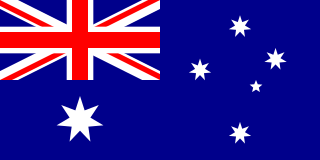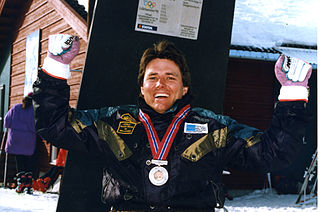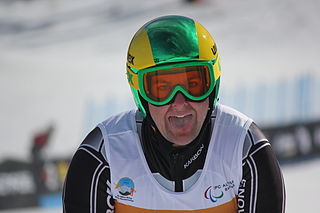
The 1998 Winter Paralympics were held in Nagano, Japan from 5–14 March 1998. At the Games, Australia was represented by four male alpine skiers. Australia tied for 16th place with Denmark, out of 21 Nations on the overall medal tally. James Patterson, an LW9 standing skier, won Australia's two medals - one gold and one bronze.

James Lawrence Paterson, is an Australian Paralympic skier who has cerebral palsy.

Australia sent a delegation to compete at the 1988 Winter Paralympics in Innsbruck, Austria, which was held between 17–24 January 1988. This marked the nation's fourth appearance at the Winter Paralympics. The delegation sent a group of five alpine skiers as they wouldn't get a medal in these games.

Australia competed at the 1992 Winter Paralympics in Tignes and Albertville in France. They were the first winter Paralympics to be celebrated concurrently with the Olympic Games. The official logo of the Games was designed by Jean-Michel Folon. It depicts a bird with broken wings, soaring high across the peak of a mountain. This was used to reflect the sporting abilities of the athletes at the Games. The official mascot, Alpy, designed by Vincent Thiebaut, represented the summit of the Grande Motte mountain in Tignes. Alpy was shown on a mono-ski to demonstrate its athleticism and the colours of white, green and blue were used to represent purity/snow, hope/nature and discipline/the lake. The 1992 Games were where Australia won their first winter medals at the Paralympics. Michael Milton won Australia's first gold with a win in the men's slalom LW2. Milton also won a silver medal in the men's super-G LW2. At these Games, Australia was represented by 5 male athletes. Australia was placed 12th in the overall medal tally for the Winter Games winning a total of 4 medals: 1 gold, 1 silver and 2 bronze.

The 1994 Winter Paralympics were held in Lillehammer, Norway. Australia sent six male skiers, who won three gold, two silver and four bronze medals. Australia, at the time, achieved their best ever performance at a Winter Paralympics, finishing 5th overall in the alpine skiing competition, 9th in the medal standings, and 11th in the total medal count out of 31 nations.

Michael Joseph Norton, was an Australian Paralympic alpine skier. As a paraplegic sit skier, he won two gold medals at the 1994 Lillehammer Winter Paralympics.
LW12 is a para-alpine and para-Nordic sit skiing sport class defined by the International Paralympic Committee (IPC). An LW12 skier needs to meet a minimum of one of several conditions including a single below knee but above ankle amputation, monoplegia that exhibits similar to below knee amputation, legs of different length where there is at least a 7 centimetres difference, combined muscle strength in the lower extremities less than 71. For international competitions, classification is done through IPC Alpine Skiing or IPC Nordic Skiing. For sub-international competitions, classification is done by a national federation such as Alpine Canada. For para-alpine, this class is subdivided into two subclasses.: LW12.1 and LW12.2. A new sit-skier competitor with only national classification will compete as LW12.2 in international competitions until they have been internationally classified.

LW11 is a para-alpine and para-Nordic sit skiing sport class, a classification defined by the International Paralympic Committee (IPC for people with paralysis in the lower extremities and people with cerebral palsy that affects the lower half of the body. Outside of skiing, the competitor in this class is unable to walk. For international competitions, classification is done through IPC Alpine Skiing or IPC Nordic Skiing. For sub-international competitions, classification is done by a national federation such as Alpine Canada.

LW10 is a para-alpine and para-Nordic sit-skiing classification for skiers who cannot sit up without support. For international skiing competitions, classification is conducted by IPC Alpine Skiing and IPC Nordic Skiing, while national federations such as Alpine Canada handle classification for domestic competitions.

LW1 is a para-alpine standing skiing classification for people with severe lower extreme disabilities in both extremities. It includes both skiers with amputations and cerebral palsy. International classification is done through IPC Alpine Skiing, and national classification through local national sport federations. LW1 classified skiers use outriggers, and two skis or one ski with a prosthesis. Other equipment is used during training such as ski-tips, ski-bras, and short skis.

LW2 is a para-alpine and para-Nordic standing ski sport class defined by the International Paralympic Committee (IPC). Competitors in this class have severe disability in a lower limb, which may be a result of an amputation, or arthrodesis in the leg and hip. Depending on the type of skiing, the international classification process for LW2 skiers is handled by the IPC Alpine Skiing Technical Committee and IPC Nordic Skiing Technical Committee. National sport federations handle classification on the lower levels.
LW3 is a para-alpine and para-Nordic standing skiing sport class defined by the International Paralympic Committee (IPC) for skiers with a disability affecting both legs, with double below knee amputation or a combined strength total for both legs of 60, with 80 as the baseline for people without disabilities. For international skiing competitions, classification is done through IPC Alpine Skiing or IPC Nordic Skiing. The classification has two subclasses for para-alpine skiing: LW3.1 which is for people with double below the knee amputations or similar disabilities, and LW3.2 which is for people with cerebral palsy that involves moderate athetoid, moderate ataxic impairment or slight diplegic involvement.
LW5/7 is a standing para-alpine and para-Nordic skiing classification for skiers with upper extremity issues in both limbs that may include double amputation of both arms and hands or dysmelia of the upper limbs. The class has three subclasses defined by the location of the disability on the upper extremities. International classification is done by IPC Alpine Skiing and IPC Nordic Skiing. On the national level, classification is handled by national sports federation such as Cross-Country Canada.

Mitchell Gourley is an Australian Paralympic alpine skier who competed for Australia in the downhill, super-G, giant slalom, slalom and super combined events at four Winter Paralympics - 2010 to 2022. He was Australian team co-captain with Joany Badenhorst at the 2018 Winter Paralympics. At the 2022 Winter Paralympics, he and Melissa Perrine carried the Australian flag in the opening ceremony. At the 2017 IPC Alpine Skiing World Championships in Tarvisio, Italy he won the gold medal in the men's Super Combined Standing.
Peter Williams is a New Zealand Olympic para-alpine sit-skier from Auckland. He graduated from the Auckland University of Technology in 2005. Passing on the 2002 Winter Paralympics in order to pursue his education, he competed at the 2010 Winter Paralympics in the giant slalom, where he finished 19th, and the slalom where he finished 22nd.

Mark Soyer is an Australian para-alpine LW11 classified skier. He dealt with leukaemia twice as a child. At the age of 26, he severed his spinal cord during an accident while riding his motorbike on his parents' farm, and subsequently tried several different sports. Working as a manufacturing jeweller and gemologist in Melbourne, he has also been involved with para-skiing as a volunteer, and serving in administrative roles for various organisations. In 2007, he was a finalist for the Pride of Australia awards for courage.

Turkey sent a delegation to compete at the 2014 Winter Paralympics in Sochi, Russia, held between 7–16 March 2014. This marked the nation's first participation in the Winter Paralympic Games. Turkey sent two athletes; Mehmet Çekiç and Hilmi Esat Bayindirli; both were competitors in alpine skiing. The nation's best finish in any event was 18th, by Bayindirli in the men's sitting giant slalom.

Patrick Jensen is a B2 classified visually impaired Para-alpine skier from Australia. He represented Australia at the 2018 Winter Paralympics and the 2022 Winter Paralympics.
Hilmi Esat Bayındırlı, also known as Erik Bayindirli, is a Turkish-American Paralympic alpine skier, who competes in the LW11 disability class of mostly men's giant slalom, sitting event. He represented United States at the 2006 Winter Paralympics and Turkey at the 2014 Winter Paralympics. A trained jeweller, he was paralyzed below the chest following a car accident in his youth.
Klaus Salzmann is an Austrian para-alpine skier and wheelchair tennis player. He won the gold medal in the Men's Giant Slalom LW11 event in alpine skiing at the 1998 Winter Paralympics. He also represented Austria at the 1994 Winter Paralympics and at the 2006 Winter Paralympics. He also competed in wheelchair tennis at the 1996 Summer Paralympics.











